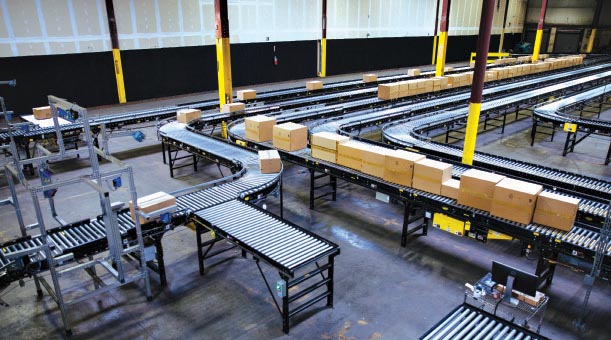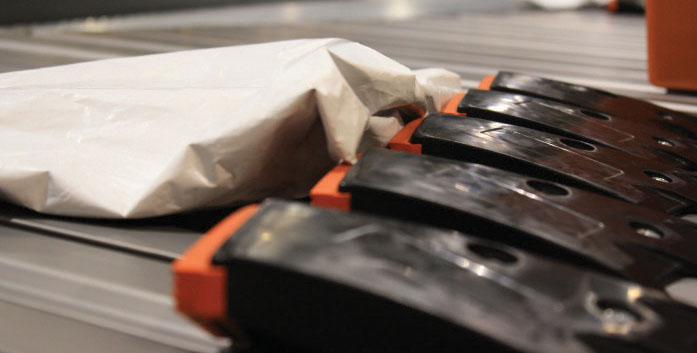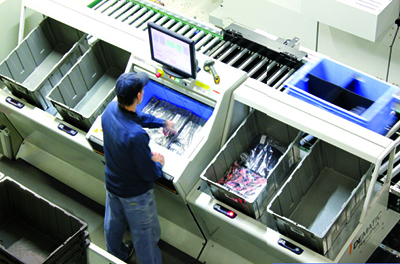Conveyors and Sortation Keep up the Pace
Pushed to the limit by e-commerce and omni-channel, the modern DC needs flexible, safe and efficient conveyor and sortation solutions that support high-velocity operations.
Whether the mission is to transform a warehouse or DC into a true omni-channel facility, speed up operations, add capacity, integrate lean manufacturing processes, work the kinks out of an existing system, or improve operator ergonomics, conveyor and sortation systems play a key role in getting companies over those finish lines.
By enabling more efficient retail, wholesale, manufacturing and distribution, these stalwart pieces of equipment also save labor by speeding up the process of moving and sorting large volumes of product or material. This is a virtual “must have” in today’s fast-paced e-commerce and omni-channel distribution environment.
“Over the last couple of years, e-commerce has really gone wild,” says Boyce Bonham, chief engineer at Hytrol. “And while Amazon is driving a lot of that momentum, pretty much everyone else is getting onboard with it in an attempt to stay competitive.” This race to win the e-commerce war directly impacts a facility’s conveyor and sortation systems, which must be able to handle a higher volume of much smaller orders shipped directly to consumers’ doorsteps.
To accommodate this shift—and to get their piece of the $523 billion in business-to-consumer (B2C) e-commerce sales and $1 trillion in business-to-business (B2B) revenues that Forrester anticipates by 2020—companies are replacing outdated systems with newer, more efficient equipment.
“With all of the goods that are being shipped direct to consumers, a lot more individual packages have to be sorted and shipped,” Bonham points out. “Whenever you run into a situation where single-item goods—not cases—have to be handled by a DC, the only way to do that efficiently is by using sorters and conveyors.”

To help companies meet this need, Hytrol introduced its E24 line of 24-volt products a few years ago, followed by a new 24-volt motor-driven roller (MDR) conveyor last year. Bonham says MDR conveyors have gained in popularity for their simplicity and flexibility. Since the MDR drive train is distributed along the conveyor length, a single piece of equipment can perform multiple functions (including different speeds, multiple directions and starting/stopping individual sections).
Bonham says Hytrol has also developed a belted zone accumulator product that can more deftly handle single items in a fast-paced, high-velocity DC or warehouse.
Using EZLogic, or electronic zero-pressure logic, the accumulator incorporates sensing accuracy of photo-electrics with discrete electronic logic control and without the use of pneumatic logic components or programmable logic controllers. Bonham says the equipment is well suited for use with products packaged in envelopes or jiffy packs, neither of which “conveys very well on rollers,” he says. “This particular accumulator product has really taken off as more companies look for ways to compete more effectively in the e-commerce arena.”
Keeping up with the “Amazon effect”
Tim Kraus, manager of product management for Intelligrated, understands that e-commerce is top-of-mind for many of his company’s customers right now, but he says a few other trends are also driving innovation and change in the conveyor and sortation space. For example, he says, a growing number of companies are using zone skipping to save time and money when shipping smaller orders to a wider swath of end users.
Defined as the process of consolidating individual packages to truckload/less-than-truckload and then sending those goods to a distribution/sorting facility that’s closer to their final destinations, zone skipping helps defray shipping costs, speed up delivery times and reduce delays. Because parcel carriers assign the rates based on distance and the number of zones that a package travels through, the shipment that enters the carrier’s system in the final delivery zone circumvents the high cost of multi-zone moves.
“Instead of handing over all of their daily shipments to UPS or FedEx by state, for instance, companies are doing their own internal sorting (e.g., inside an e-commerce deployment center),” says Kraus, “and then using zone skipping to get the goods to their final destinations faster and at a larger discount.” To adapt to this trend, Kraus says equipment manufacturers are developing systems that help companies sort outbound freight on a more granular level.
“By taking a sorting operation up one extra level—say, instead of just sorting UPS vs. FedEx vs. USPS packages—companies can get a much finer level of granularity and take advantage of zone skipping,” says Kraus. “That can return a huge benefit in terms of delivery times and costs. In fact, some of our customers are justifying the investment in sorters just on delivery time alone.”
In other words, the “Amazon effect” (namely, those next- and two-day delivery windows that we’ve all come to love) is now being traced back to the very machines that move and sort products and materials in the warehouse or DC. “We thought the main justification for zone skipping would be reduced shipping costs, which is a big win,” says Kraus. “But, as next-day delivery becomes even more important, that quick-delivery benefit is almost surpassing the need to cut costs.”
Getting down and dirty
Drilling down into specific distribution activities, Ken Ruehrdanz, manager of the distribution systems market for Dematic North America, sees three key developments taking place right now. The first is an increase in goods-to-person workstations, a trend that’s being supported by modular conveyor (i.e., the structure that indexes the load into a precise position where it is accessed by a worker).

“Modular conveyor can sequence cartons and totes into and out of the goods-to-person workstation,” says Ruehrdanz. “The conveyor configuration accommodates worker ergonomics.” Solutions like Dematic’s RapidPick system, for example, allow operators to stay in one place while items are delivered to the pick station in precise sequence—heavy items first, fragile items last, for lot control, by family group, or in another specific sequence.
Ruehrdanz says more companies are also using robotic piece-picking solutions like Dematic’s RapidPick XT for order fulfillment. Again, he says modular conveyor is enabling this development. The robot serves as the “centerpiece” of the cell, but requires a conveyor module that can sequence and position inventory containers and order containers for that robot. “Modular conveyor indexes the load into a precise location where it is then accessed by the robot,” says Ruerhrdanz
Lastly, Ruehrdanz says companies are creating more flexible and fluid conveyor and sortation operations within their facilities, and all with the goal of being able to quickly adapt to a new distribution need, demand and/or configuration. “The accelerating rate of change in operational requirements is driving the need to implement conveyor systems that can be reconfigured,” says Ruehrdanz. “Our steerable wheel sorter module is one example of a product that can be relocated in the existing side frame.”
Putting a spotlight on safety
As he looks around at the typical warehouse or DC operation, Kraus spots another requirement that’s driving companies to invest in new or upgraded sortation and conveyor technology: worker safety.
“We’re definitely seeing a trend toward greater safety requirements in the industry,” says Kraus, who points to the rise in automated systems as a key driver of this trend. And with the uptick in e-commerce and omni-channel distribution comes the need for more humans—many of them temporary in nature—to operate the traditional and automated equipment. This, in turn, creates a perfect storm for more accidents and injuries.
“There’s a greater need for the system to be safe while also eliminating the chance that people may hurt themselves,” says Kraus. According to OSHA regulations, some of the basic safety requirements for conveyors include a means for stopping the motor or engine; audible warning signals that must be used before starting up a conveyor; and, where a conveyor passes over work areas, aisles or thoroughfares, suitable guards to protect employees working in and around the equipment.
“We’re now seeing requirements for more guards and/or for areas to be blocked off from people getting next to the equipment,” says Kraus, “where in the past it was common in the industry for [workers] to be closer to that operating equipment.” He says Intelligrated works with its customers to ensure that its systems meet those safety requirements, many of which are built into the manufacturer’s standard offerings.
Bonham has also picked up on an increased focus on safety. He says that as companies strive to move products in and out of their facilities faster, and in smaller packages and quantities, that the spotlight on safety will likely shine even brighter. “Safety has always been of utmost importance,” says Bonham, “and this faster-to-market environment is pushing everyone to think more carefully about how to make equipment even safer for the people who use it and work with it on daily basis.”













